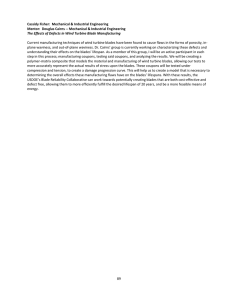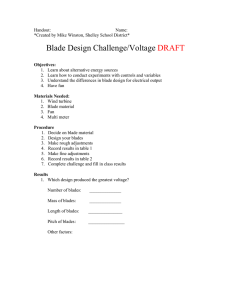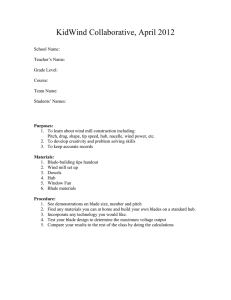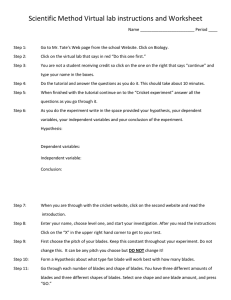Expert Interview Bladena: Wind turbine blades require structural
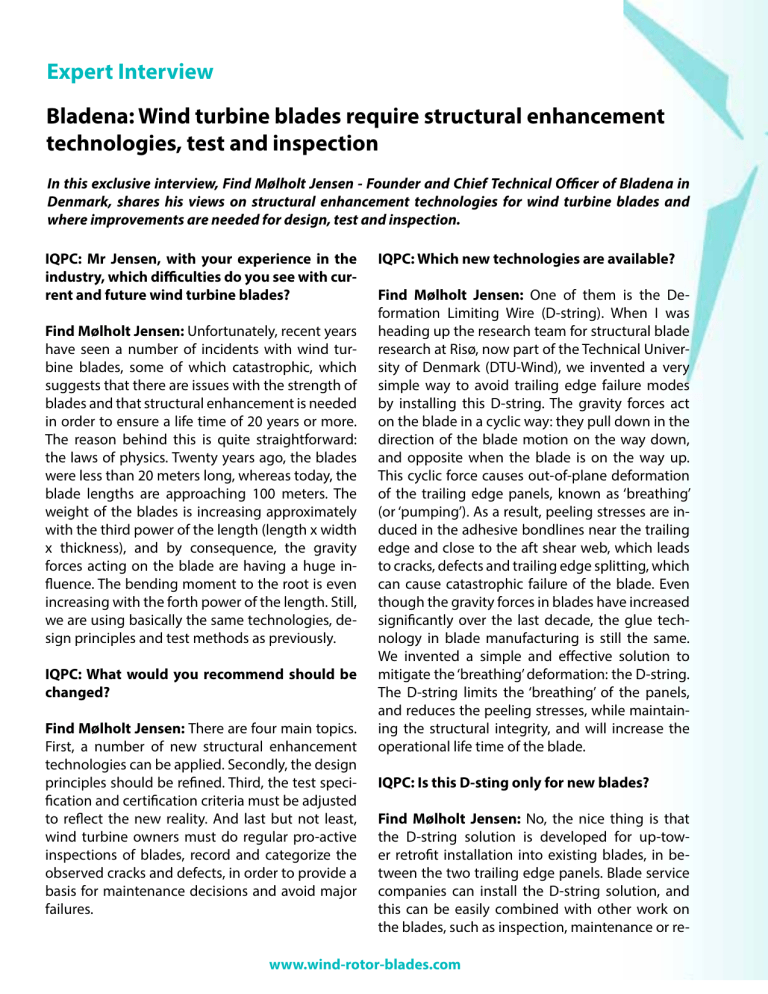
Expert Interview
Bladena: Wind turbine blades require structural enhancement technologies, test and inspection
In this exclusive interview, Find Mølholt Jensen - Founder and Chief Technical Officer of Bladena in
Denmark, shares his views on structural enhancement technologies for wind turbine blades and where improvements are needed for design, test and inspection.
IQPC: Mr Jensen, with your experience in the industry, which difficulties do you see with current and future wind turbine blades?
Find Mølholt Jensen: Unfortunately, recent years have seen a number of incidents with wind turbine blades, some of which catastrophic, which suggests that there are issues with the strength of blades and that structural enhancement is needed in order to ensure a life time of 20 years or more.
The reason behind this is quite straightforward: the laws of physics. Twenty years ago, the blades were less than 20 meters long, whereas today, the blade lengths are approaching 100 meters. The weight of the blades is increasing approximately with the third power of the length (length x width x thickness), and by consequence, the gravity forces acting on the blade are having a huge influence. The bending moment to the root is even increasing with the forth power of the length. Still, we are using basically the same technologies, design principles and test methods as previously.
IQPC: What would you recommend should be changed?
IQPC: Which new technologies are available?
Find Mølholt Jensen: One of them is the Deformation Limiting Wire (D-string). When I was heading up the research team for structural blade research at Risø, now part of the Technical University of Denmark (DTU-Wind), we invented a very simple way to avoid trailing edge failure modes by installing this D-string. The gravity forces act on the blade in a cyclic way: they pull down in the direction of the blade motion on the way down, and opposite when the blade is on the way up.
This cyclic force causes out-of-plane deformation of the trailing edge panels, known as ‘breathing’
(or ‘pumping’). As a result, peeling stresses are induced in the adhesive bondlines near the trailing edge and close to the aft shear web, which leads to cracks, defects and trailing edge splitting, which can cause catastrophic failure of the blade. Even though the gravity forces in blades have increased significantly over the last decade, the glue technology in blade manufacturing is still the same.
We invented a simple and effective solution to mitigate the ‘breathing’ deformation: the D-string.
The D-string limits the ‘breathing’ of the panels, and reduces the peeling stresses, while maintaining the structural integrity, and will increase the operational life time of the blade.
Find Mølholt Jensen: There are four main topics.
First, a number of new structural enhancement technologies can be applied. Secondly, the design principles should be refined. Third, the test specification and certification criteria must be adjusted to reflect the new reality. And last but not least, wind turbine owners must do regular pro-active inspections of blades, record and categorize the observed cracks and defects, in order to provide a basis for maintenance decisions and avoid major failures.
IQPC: Is this D-sting only for new blades?
Find Mølholt Jensen: No, the nice thing is that the D-string solution is developed for up-tower retrofit installation into existing blades, in between the two trailing edge panels. Blade service companies can install the D-string solution, and this can be easily combined with other work on the blades, such as inspection, maintenance or rewww.wind-rotor-blades.com
pair. Obviously, the solution can also be applied on blades that are taken down for repair, and on new blades.
IQPC: Is this product commercially available, and has it been installed in live operation?
engineers only use the linear simulation method, there will be certain aspects of mechanical strength that cannot be modelled correctly. Unfortunately, some of the international standards only call for linear FEM analysis, so this is definitely misleading.
Find Mølholt Jensen: Yes, indeed. The first
D-string solutions were installed in wind turbines in Denmark and in the US, and the D-string solution has been in operation for more than a year.
IQPC: Which other technologies can be used for structural enhancement?
IQPC: Why should test standards be modified?
Find Mølholt Jensen: The international test standards that are used by certification organizations and test laboratories, were developed many years ago, and modern blades have out-grown these standards, so to speak. There are three areas in particular that need immediate attention.
Find Mølholt Jensen: When I was at Risø - DTU, we developed seven different patented solutions, all for structural enhancement of the blades. Apart from the D-string, we developed technologies such as the Shear Cross Stiffener, which is one or several mechanical crosses, inserted between the shear webs, to improve the structural performance; in particular when the blade is exposed to torsional loads. A cross stiffener prevent the shear webs to distort in transverse shear. This is important to mitigate leading edge cracks. By preventing this deformation and absorbing energy from the structural dampers, edgewise vibrations can be avoided. Like the D-string, the Cross Stiffener can be mounted as a retrofit solution into existing blades as well as in new blades. Another patented solution is the Spar Cap Stiffener. This is used to improve the strength of the spar caps. When a blade is exposed to flapwise bending, the spar caps are flattening and this local deformation results in transverse tension failure in the longitudinal fibres.
IQPC: How can design principles be improved?
Find Mølholt Jensen: The use of Finite Element
Method (FEM) in mechanical design is wide spread. It is very important to use non-linear modelling, and not just linear modelling, as certain aspects of mechanical strength can only be simulated and understood correctly by using non-linear
FEM simulations. For example, the deformation of the spar caps, due to pressure from flapwise bending. The results of linear and non-linear FEM simulation are very different here. So when design
• Normally, blades are tested in full scale tests by bending them with a flapwise load or an edgewise load. However, with the increased gravity forces, the loading on blades during operation is a combination of both, and therefore it is important to test the blades with combined loading. This is really very simple. The blade is mounted at the root, and the only thing needed is to rotate the blade to a different position, for example 30 degrees, and do the loading test in this position. No extra time, no extra cost, just testing at a condition that reflects realistic loading.
• The bending of the blades during the tests takes place by pulling, and for this purpose wooden clamps are applied to closely fit the form of the blade. Although the idea with such a loading clamp is to distribute the pulling force around the surface of the blade (and to avoid damage due to this), the undesirable effect is that certain failure modes are in fact inhibited by the clamps. The trailing edges, for example, are protected by the clamps and kept in a rigid position, and therefore certain trailing edge failures are not discovered when using these clamps during testing. At Risø -
DTU we used a simple metal plate to connect the pulling force to the blade. Again, no extra cost, but using realistic testing conditions.
• Longer, larger and heavier blades must be tested for torsion failure modes, as torsional resonance frequency is lower for larger blades and therefore closer to the operational frequency of the turbine. The torsional resonance frewww.wind-rotor-blades.com
quency is thereby getting closer to the flapwise resonance frequency and therefore coupling to the flapwise frequency can occur. This phenomenon is called flutter. Testing for torsional loading is again quite simple. The loading point of attack just has to be off-set away from the shear center.
There are some other improvements, but these three are the most important, easy and cost-efficient to implement. In contrast, the failure modes that could be overlooked, can work out to be very expensive.
Find Mølholt Jensen: I founded Bladena in 2011, together with DTU and investors, to exploit the structural enhancement patents on a commercial basis. The focus of Bladena is to provide products and services for structural enhancement technologies for wind turbine blades. Bladena is participating in several industry cooperation projects, funded by Danish government, where these technologies are tested and verified in live operational wind turbines.
IQPC: Why are blade inspections important?
Find Mølholt Jensen: For wind turbine owners, the budget for operations and maintenance (O&M) is divided between several components. On the top of the list are the drive train, gear boxes, bearings, generators and electrical systems. During recent years, the industry has realized that the blades also need repair and maintenance in order to ensure their life time. With the need for structural enhancement, as discussed above, the wind turbine owner should do regular inspections of the condition of the blade. These inspections should cover the aspects that call for immediate attention, such as lightning strikes and erosion of leading edge.
But as service work is being performed at the wind turbine blades, the service company can also at the same time do a visual blade inspection – at very little additional cost. The service companies just need to know what to look for. In order to support this effort, Bladena has developed a software tool, called Guide2Defect, an on-line damage categorization tool, enabling users to accurately describe and categorize any identified damage on a blade in a standardized descriptive framework. It allows users to compare defects across wind turbine fleets, blade manufactures and wind classes and hence identify trends and failure modes in a systematic way. The use of such a database tool provides the data to initiate root-cause analysis or maintenance work – at a time where the cost of maintenance is still modest, instead of waiting until a crack or defect develops into a serious and expensive failure.
About Find Mølholt Jensen:
Dr. Find Mølholt Jensen is the Chief Technical Officer of Bladena in Denmark. Previously, he was head of the blade structural research group at Risø – DTU.
During a decade of research, he and his team developed a series of patented technologies for structural enhancement of wind turbine blades. These patents have been transferred to Bladena, which he established in 2011.
IQPC: Are you still working on research?
www.wind-rotor-blades.com

